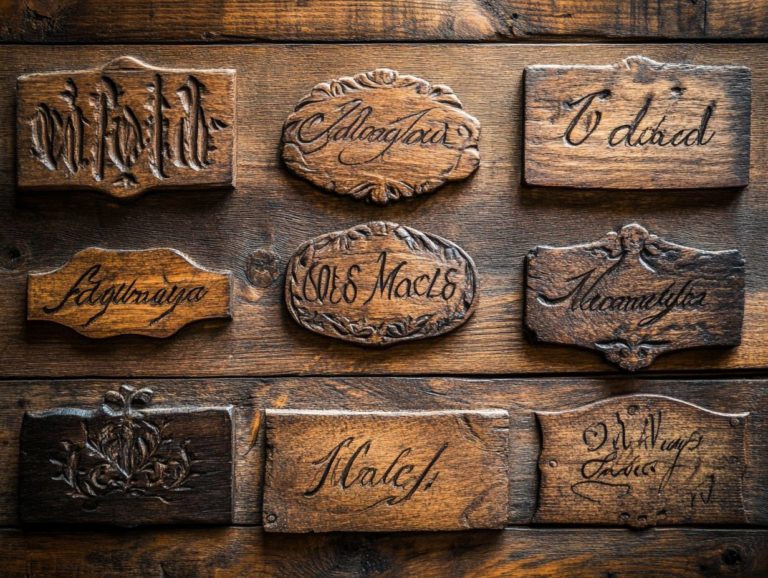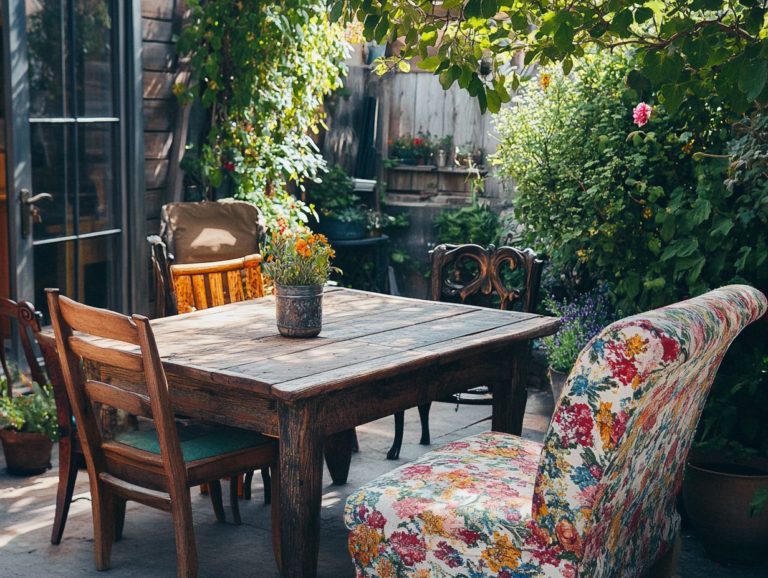Exploring the Global Influence on Vintage Furniture
Vintage furniture boasts a rich history that beautifully reflects the cultural tapestry of our world. From its origins to the evolution of styles influenced by diverse regions, this exploration reveals the intricate factors that have shaped vintage design.
Whether you’re a seasoned collector or just beginning your journey, you’ll discover key characteristics of popular styles, invaluable tips for finding and restoring pieces, and insights into the value and emerging trends of vintage furniture. Dive into this fascinating world now and uncover the beauty of vintage elegance!
Contents
- Key Takeaways:
- The History of Vintage Furniture
- Global Influence on Vintage Furniture
- Popular Vintage Furniture Styles
- Collecting and Restoring Vintage Furniture
- The Value of Vintage Furniture
- Future Trends in Vintage Furniture
- Frequently Asked Questions
- In what ways has globalization affected the production and availability of vintage furniture?
- What are some popular global influences on vintage furniture?
- What are some tips for incorporating vintage furniture into modern interiors?
- Where can I find high-quality and authentic vintage furniture?
Key Takeaways:
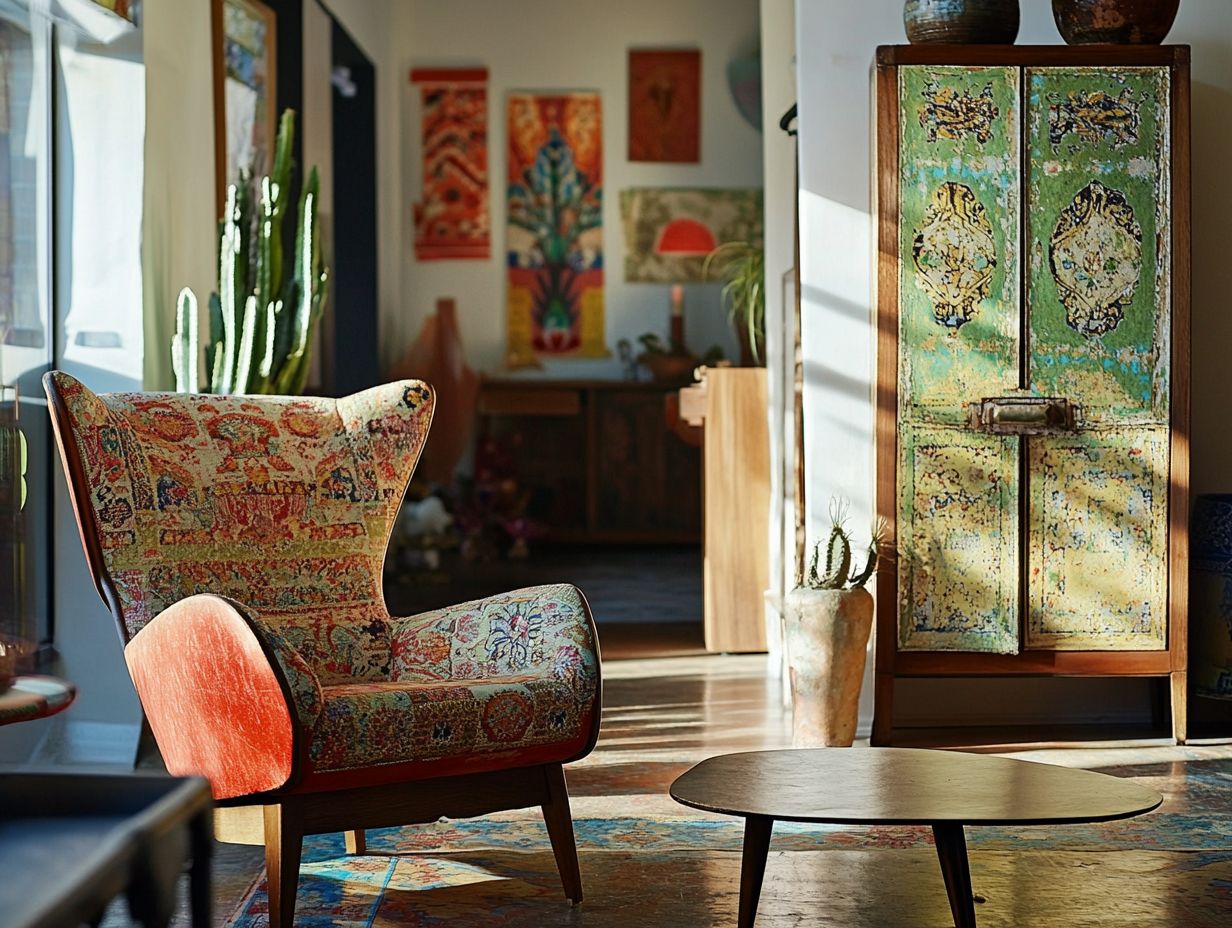
- Vintage furniture has a rich history that has evolved over time, influenced by various regions and cultures.
- Key characteristics of popular vintage furniture styles help identify and appreciate the value of these pieces.
- Understanding the global influence on vintage furniture is important for pricing considerations and staying informed on future trends in the market.
The History of Vintage Furniture
The history of vintage furniture unfolds like a rich tapestry, intricately woven from diverse cultural influences, craftsmanship, and the historical contexts that have shaped furniture design over the centuries.
From sleek mid-century modern pieces, known for their minimalist design and functional aesthetics, to the opulence of Art Deco designs, characterized by bold geometric patterns and luxurious materials, each era showcases unique styles and values. Vintage furniture reflects more than just design trends; it embodies a profound connection to cultural heritage across the globe, highlighting the meticulous craftsmanship and storytelling inherent in each piece. To explore this further, check out the impact of vintage furniture on interior design.
This journey into the past reveals how historical influences continue to echo in today s furniture aesthetics.
Origins and Evolution
The origins and evolution of vintage furniture reveal a rich tapestry of styles and cultural influences that characterize the unique designs of each era.
From the ornate carvings of the Baroque period to the sleek lines of Mid-Century Modern, every historical phase has left an unforgettable imprint on craftsmanship and aesthetic appreciation. The Renaissance celebrated intricate woodwork, while the Industrial Revolution introduced new materials, paving the way for mass production and greater accessibility.
As tastes have transformed over the years, there s also been a growing emphasis on sustainability in vintage pieces, often utilizing reclaimed wood and eco-friendly finishes. Delving into these milestones not only showcases distinct styles like Art Deco and Shaker but also sheds light on how the evolution of furniture mirrors broader societal shifts and technological advancements.
Global Influence on Vintage Furniture
The global influence on vintage furniture reveals the rich tapestry of cultural influences and craftsmanship that have shaped furniture styles across continents. It showcases a captivating interplay between regional design aesthetics and historical trends.
From the clean lines of Scandinavian minimalism to the intricate patterns of Moroccan design, each region brings its own unique story to the world of vintage furniture, highlighting the artistry and functionality woven into every piece. To truly appreciate these stories, it’s important to explore understanding the value of vintage furniture.
As you explore your furniture choices, recognizing these cultural influences is essential to appreciating the timeless allure of vintage designs. This evolution, highlighted in the evolution of vintage furniture styles, emphasizes the need to preserve craftsmanship legacies, even in the face of modern design innovations.
Regions and Cultures that Shaped Design
Regions and cultures around the world have profoundly influenced furniture design. Each contributes distinct elements that enrich the tapestry of vintage furniture.
Take Asian regions, for instance. They often highlight intricate woodwork and elaborate lacquer finishes. These designs draw inspiration from nature and spiritual motifs that evoke tranquility and reverence.
Conversely, European styles seamlessly blend classical elegance with modern minimalism. They reflect historical shifts and a craftsmanship legacy that spans centuries.
Then there s African craftsmanship, which bursts with vibrant colors and bold geometric patterns. Often, these pieces narrate stories through their form and decoration.
These cultural influences elevate the aesthetic appeal. They also imbue vintage pieces with historical significance, transforming them into treasured artifacts that enhance homes across the globe.
Popular Vintage Furniture Styles

Popular vintage furniture styles, like mid-century modern and Art Deco, captivate collectors and enthusiasts alike. Each showcases unique design elements that reflect the aesthetic values of its era.
These styles tell a story through their craftsmanship, materials, and innovative designs. They contribute to the timeless allure of vintage pieces.
Traditional styles, adorned with intricate patterns and luxurious materials, remain in demand. They offer a classic appeal that harmonizes with contemporary home decor.
By diving into these popular styles, you can truly appreciate the emotional resonance woven into vintage furniture.
Identifying Key Characteristics
Identifying the key characteristics of vintage furniture requires delving into the craftsmanship, design aesthetics, and materials that set each style apart.
Take mid-century modern pieces, for example. Their clean lines and functional forms often showcase a playful use of color, blending utility with artistry.
Consider the opulence of Baroque furniture, marked by intricate carvings and luxurious fabrics. This style captures the grandeur of its era.
In contrast, Arts and Crafts furniture embraces simplicity and handcrafted quality. It often uses natural materials like oak.
These styles present distinct visual appeal and encapsulate the historical context and techniques of their time. They weave a rich tapestry of artistry that appeals to enthusiasts and collectors alike.
Collecting and Restoring Vintage Furniture
Collecting and restoring vintage furniture is an exciting adventure that captivates anyone who appreciates quality craftsmanship. This pursuit champions environmental sustainability and connects you with the rich history woven into each item.
By employing craft methods during restoration, you can revive the authenticity and timeless charm of vintage furniture. This ensures these treasures remain cherished in contemporary home decor.
As vintage trends evolve, the significance of restoration in upholding the integrity of these pieces cannot be overstated.
Tips for Finding and Refurbishing Pieces
Finding and refurbishing vintage furniture demands a discerning eye for craftsmanship and unique styles. You must also have a genuine appreciation for the narratives these pieces carry.
To value these artifacts, recognize the quality within their artistry. Pay close attention to joinery techniques, the materials used, and distinctive features that showcase a piece’s individuality.
When you’re hunting at thrift stores or estate sales, look for signs of durability. Older constructions often exude timeless charm.
Once you identify a worthy piece, embrace best practices during the refurbishment process. Opt for environmentally friendly products and aim to preserve original finishes whenever possible.
This approach enhances the furniture’s character while allowing it to shine in modern spaces, maintaining its historical allure.
Are you ready to discover the timeless beauty of vintage furniture?
The Value of Vintage Furniture
The value of vintage furniture hinges on a blend of factors, including craftsmanship, historical factors, and market demand. These elements shape pricing in this refined arena.
When you encounter pieces that exemplify exceptional craftsmanship and unique design traits, they command higher prices. This underscores their importance within the historical tapestry of furniture design.
Additionally, factors like brand reputation and rarity significantly contribute to a vintage piece’s market value. Understanding these dynamics is essential for collectors and enthusiasts, helping you navigate the captivating world of the best places to find vintage furniture with confidence.
Factors that Affect Pricing
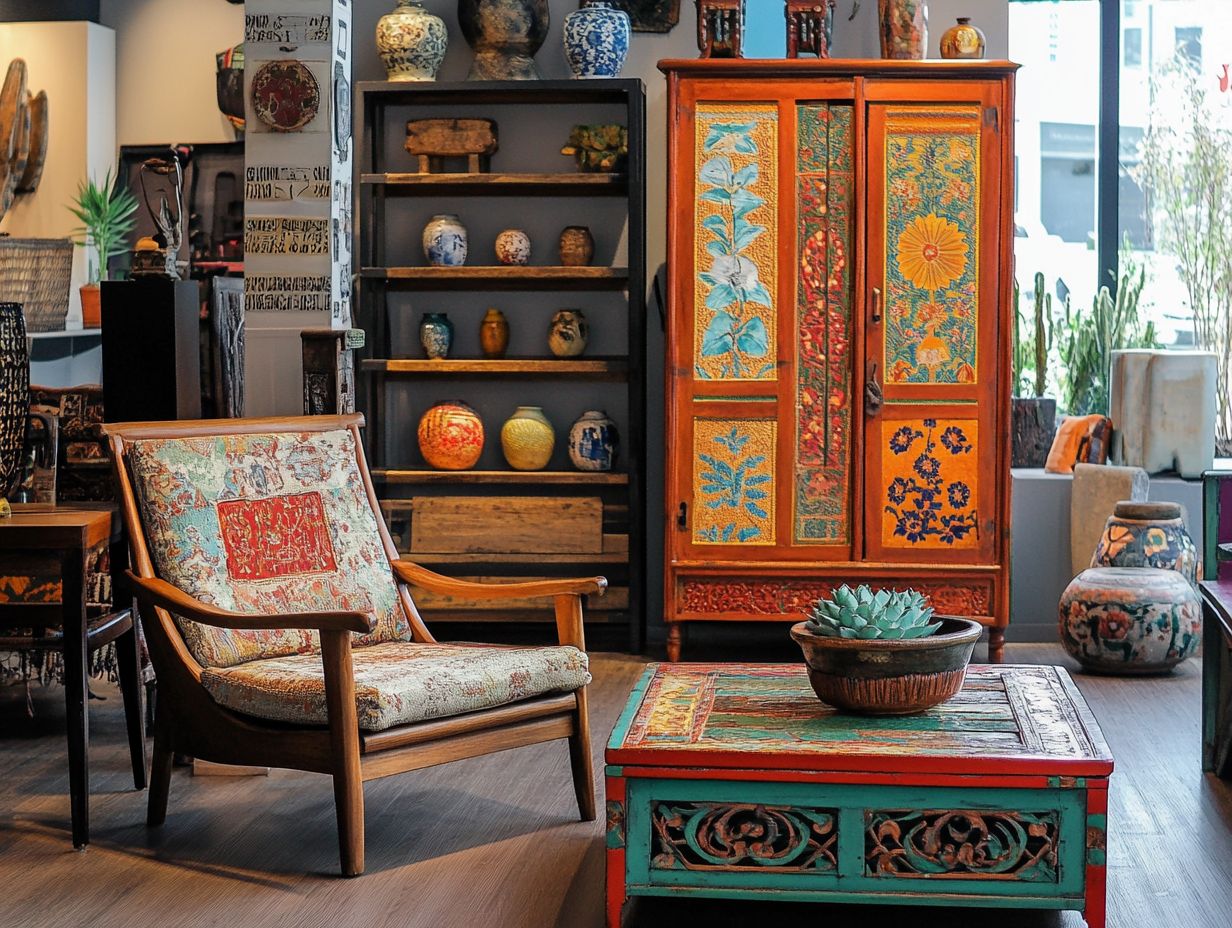
Several factors influence the pricing of vintage furniture, including craftsmanship, market demand, and the piece’s historical significance.
Understanding these elements is essential for anyone looking to evaluate an item’s true value. Craftsmanship is key; the quality of materials and techniques used speaks to the durability and aesthetic appeal of the piece.
Market demand also plays a significant role in pricing. Trends can shift dramatically based on popular styles or designers, meaning what may once have seemed outdated can suddenly become the hottest item on the market.
A piece’s historical significance its age and provenance greatly enhances its appeal, transforming it from a mere functional item into a cherished artifact with a compelling story.
By taking all these factors into account, you ll be ready to make smart choices and invest wisely in your vintage furniture journey.
Future Trends in Vintage Furniture
Future trends in vintage furniture will be influenced by an increasing emphasis on sustainable design and modern luxury. This invites you to experience a harmonious blend of vintage charm and contemporary elegance.
As collectors and designers delve deeper into the allure of craftsmanship and artisanal techniques, the perception and valuation of vintage pieces are set for remarkable transformation in the years ahead.
With environmental sustainability taking center stage, expect the vintage furniture market to embrace a fusion of traditional styles and innovative, eco-friendly practices. This ensures that the legacy of craftsmanship not only endures but thrives.
Predictions and Influences on the Market
Predictions for the vintage furniture market indicate that craftsmanship and sustainable design will increasingly shape your preferences in the years to come.
In the future, your love for finely crafted pieces, coupled with eco-conscious practices, will transform your buying habits. As a discerning consumer, you’re likely drawn to items that please the eye and tell a meaningful story rooted in traditional craftsmanship. You seek vintage furniture with character that mirrors your values, favoring sustainability over mass production.
This shift may inspire artisans to seamlessly integrate modern techniques with vintage aesthetics, breathing new life into classic designs. As more people become aware of environmental issues, authentic vintage furniture will likely become even more desirable, as each piece carries intrinsic value in both history and sustainability.
Frequently Asked Questions
What is vintage furniture and why is it important to explore its global influence?
Vintage furniture refers to pieces that are at least 20 years old. Exploring its global influence helps us understand how different cultures and regions have shaped the design, materials, and techniques used in creating these pieces.
How does exploring the global influence on vintage furniture help in preserving cultural heritage?
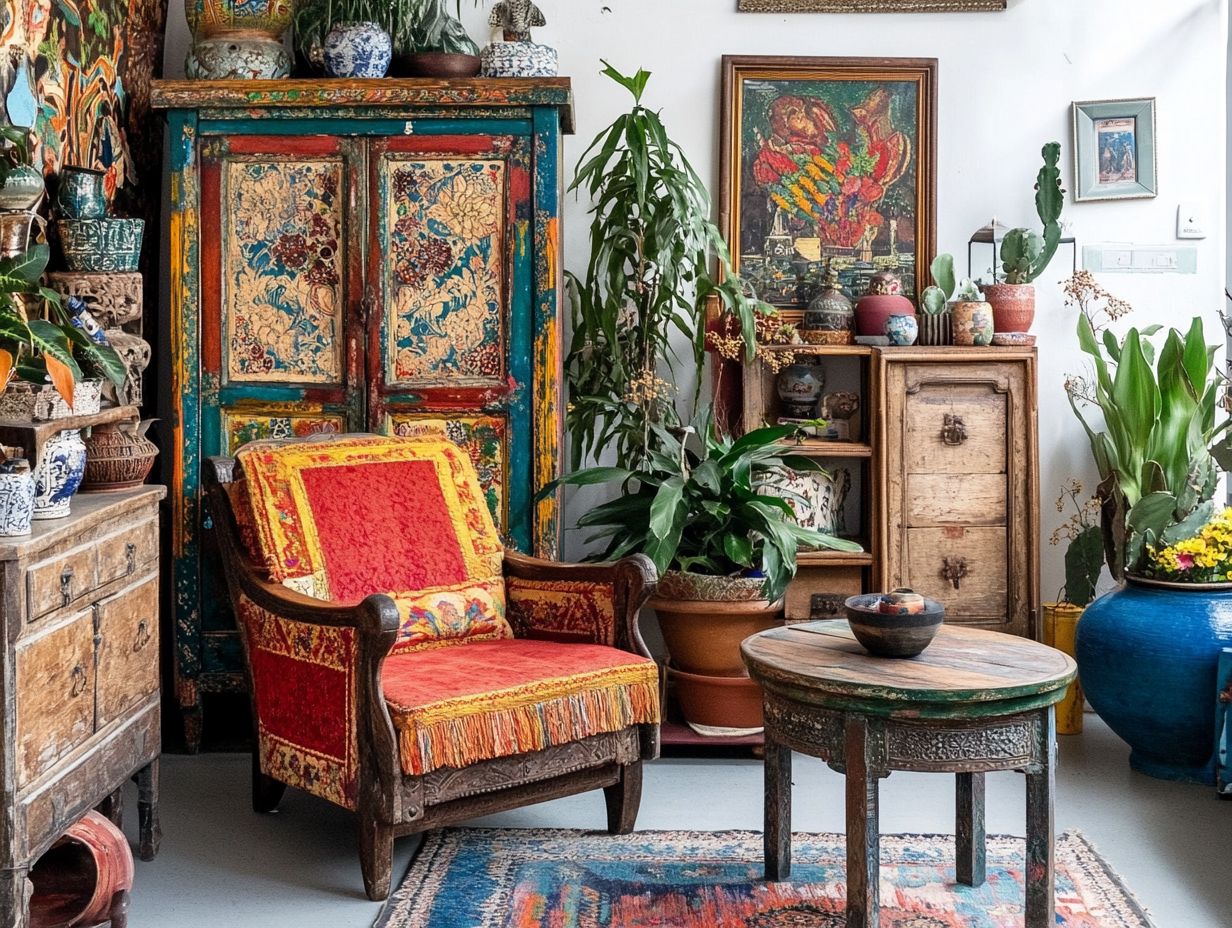
By understanding the different influences on vintage furniture, we can appreciate its significance in preserving the cultural heritage of a region or country. It also helps us recognize the value of these pieces in terms of design, craftsmanship, and historical context.
In what ways has globalization affected the production and availability of vintage furniture?
Globalization has made vintage furniture accessible to a wider audience. With international trade and online shopping, you can explore unique pieces from around the world.
What are some popular global influences on vintage furniture?
Popular global influences on vintage furniture include the stylish Art Deco movement from France. Don’t miss the striking mid-century modern designs from Scandinavia and the beautiful carvings of Chinese and Indian furniture.
What are some tips for incorporating vintage furniture into modern interiors?
To integrate vintage furniture into modern interiors, get creative by mixing and matching pieces from different eras. Use vintage items as statement pieces while keeping a cohesive color scheme.
Where can I find high-quality and authentic vintage furniture?
Find high-quality vintage furniture at reputable antique shops and vintage markets. Online marketplaces like eBay and Etsy also offer great options, but always verify authenticity before buying.

